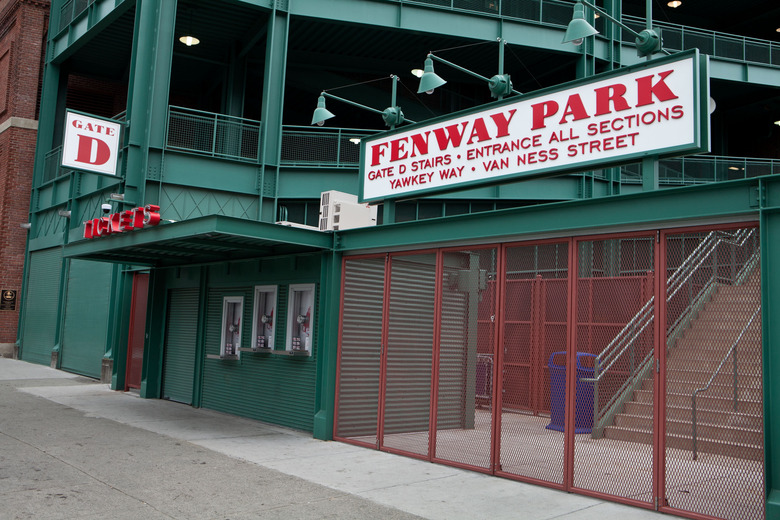How To Build A Model Of A Baseball Stadium
Since 1856, baseball has been called America's pastime. Although Abner Doubleday had been rumored to be the father of baseball, this is a myth. Alexander Cartwright is credited as the founder, as he formalized a list of baseball rules, which enabled teams to compete. In 1846, the first recorded game was in Elysian Fields between Cartwright's Knickerbockers and the New York Baseball Club, and in 1871, the first professional league started. In 1912, only four decades later, the first baseball park — Fenway Park — was built. Fenway then seated 24,400. Today, Fenway is one of the three smallest ballparks, seating 39,928; Dodger Stadium, the largest, seats 57,099. In making this model, you will use geometry to create a scaled-down model of an actual stadium; you will use algebra in calculating the dimensions.
Designing the Model
Step 1
Choose a specific stadium for the model. Each stadium is a little different in its seating arrangements, dugout, clubhouse and fencing. Choose a scale that will create a model of the desired finished size. A model that will be approximately 2-feet square may require a scale of 3 feet = 1/8 inch. A larger model could use a scale of 3 feet = 1/4 inch.
Step 2
Convert all measurements to scale. Include dugout, seating, clubhouse, fencing and any other items that will be included on the model. Write down all converted measurements.
Step 3
Choose the colors to use for the various parts of the model. Green for grass and brown for infield areas can be complemented with blues, reds, grays and white for specific items that will be included.
Building the Model
Step 1
Lay the plywood sheet on a flat surface. Draw a line from one corner across to the opposite corner. Repeat with the other corners to form an x in the center of the plywood. Turn the plywood so one corner faces toward you. Measure halfway along the line from the corner facing you to the center of the x and mark the spot with the pencil. This spot is home plate for the baseball diamond.
Step 2
Draw the first baseline and third baseline at a 90-degree angle to each other. Draw them the length previously calculated for the model. Set the pointed end of the compass at home plate. Extend the pencil to the end of the first baseline. Draw an arc across to the end of the third baseline. Sketch in all other items to be included in the model. Mark the infield, outfield, bases and pitcher's mound. Label each section to be built. For example, write "dugout" in the dugout area, "stands" in the viewing stands and so forth.
Step 3
Paint each of the items to be included in the model, moving from left to right across the bottom section of the model. Allow the paint to dry overnight. Paint in the rest of the model, including the infield, outfield and baselines. Allow the paint to dry overnight. Outline all of the buildings with black paint. Allow the paint to dry.
Step 4
Paint labels on each item with the fine paintbrush and white paint or paint a legend with the colors labeled on a separate piece of paper.
Things Needed
- Diagram of baseball stadium
- Pencil
- Paper
- Plywood sheet
- Ruler
- Compass
- Colored paint
- Medium paintbrush
- Black paint
- Fine paintbrush
TL;DR (Too Long; Didn't Read)
A 3D model can also be made using cardstock to create the buildings and stands as needed. Utilize pictures of the actual stadium to include architectural details such as the placement of advertisements.
References
- Andrew Clem: Colt Stadium
- Peninsula Pilots: Stadium Diagram
- National Baseball Hall of Fame and Museum
- 19th Century Baseball
- 19th Century Baseball: Currier & Ives Print of Elysian Fields
- CBS Boston: 100 Fenway Park Facts: 1-51
- Boston.com: Change-up: A Nip, Tuck for Fenway
- Sportige.com: Top Ten Biggest MLB Stadiums
Cite This Article
MLA
Marcotte, Dawn. "How To Build A Model Of A Baseball Stadium" sciencing.com, https://www.sciencing.com/build-model-baseball-stadium-7370691/. 24 April 2017.
APA
Marcotte, Dawn. (2017, April 24). How To Build A Model Of A Baseball Stadium. sciencing.com. Retrieved from https://www.sciencing.com/build-model-baseball-stadium-7370691/
Chicago
Marcotte, Dawn. How To Build A Model Of A Baseball Stadium last modified August 30, 2022. https://www.sciencing.com/build-model-baseball-stadium-7370691/
